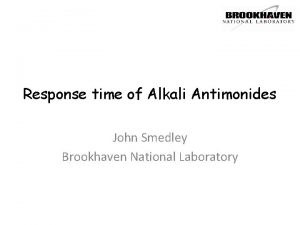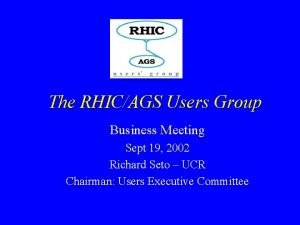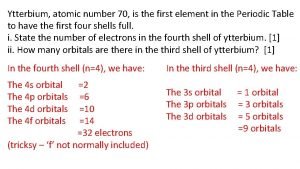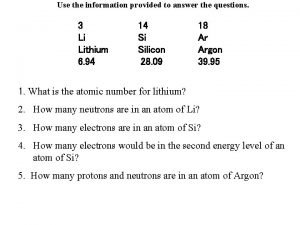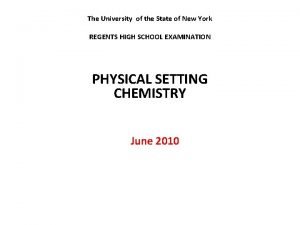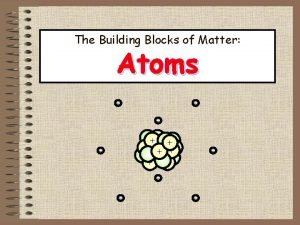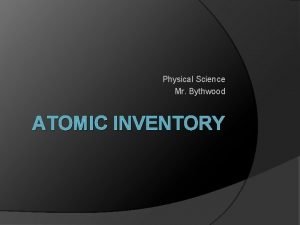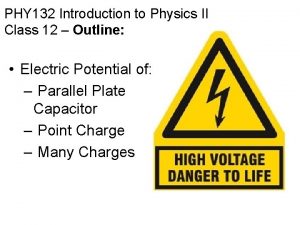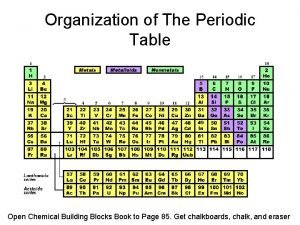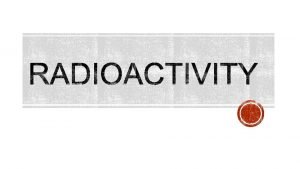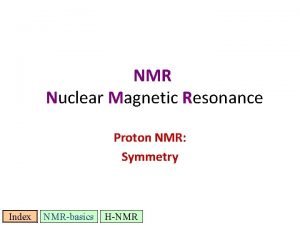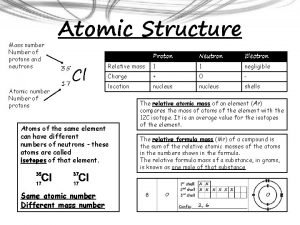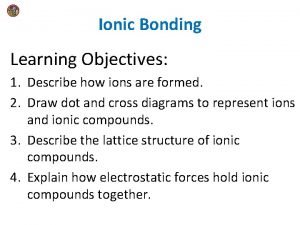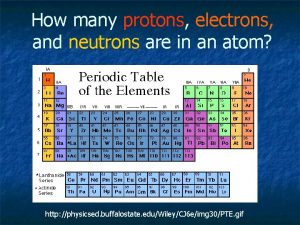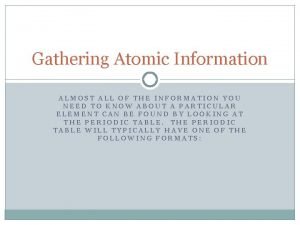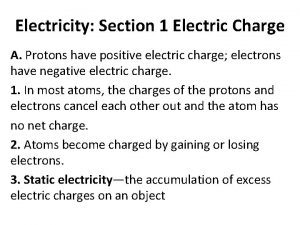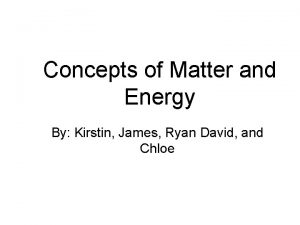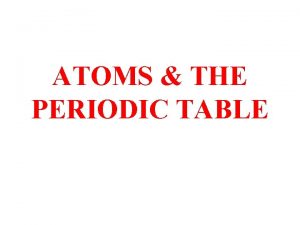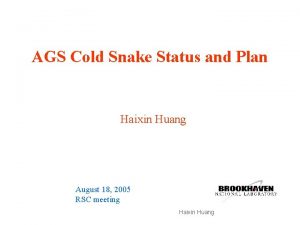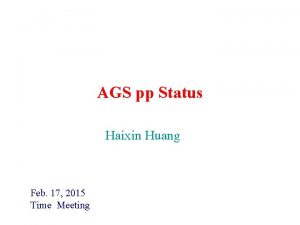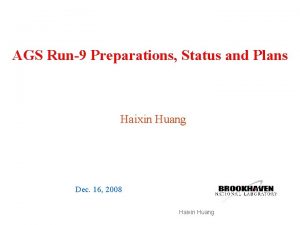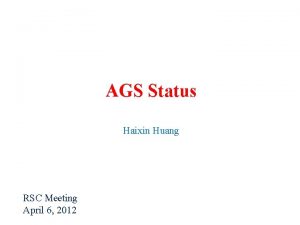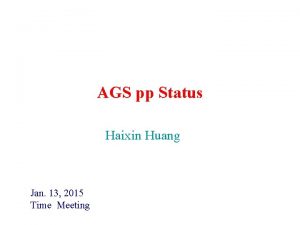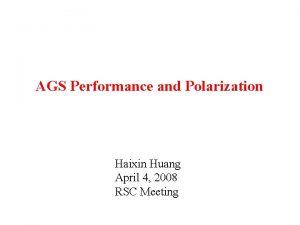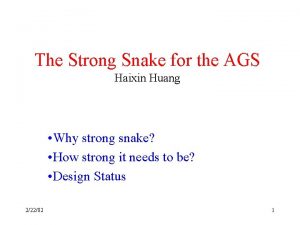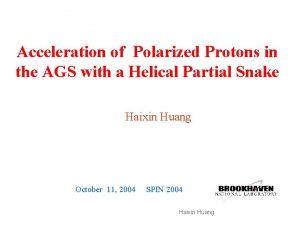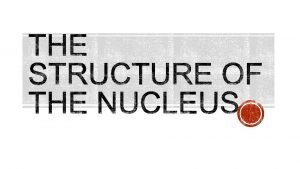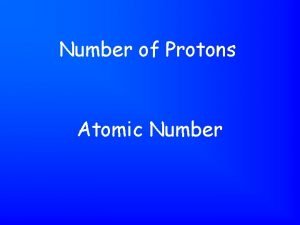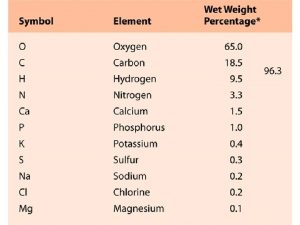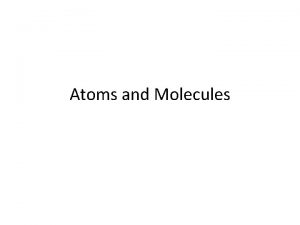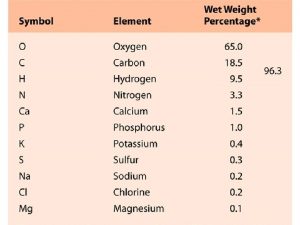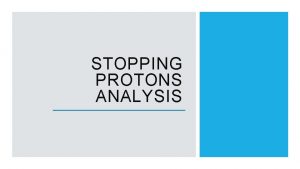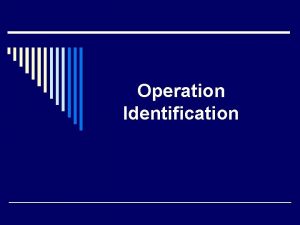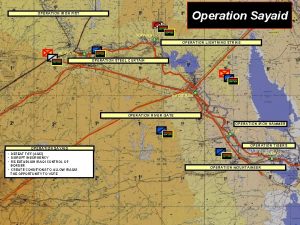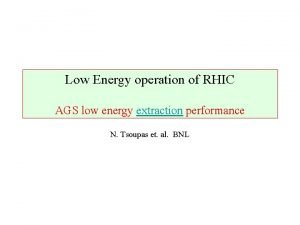Experience with AGS High Intenisty Protons Operation Haixin






























- Slides: 30

Experience with AGS High Intenisty Protons Operation Haixin Huang October 18, 2012

Brookhaven Hadron Accelerator Complex 2 Haixin Huang

AGS Complex with Beam Lines RHIC 24 -255 Ge. V 3 Haixin Huang

Booster Design Goal 1. Increase AGS proton intensity by a factor 4 to 6*1013. 2. Accelerate heavy ions with mass numbers up to 200 and beyond for RHIC heavy ion operation. 3. The design was a rapid cycling synchrotron which can accelerate proton to 1. 5 Ge. V at a 7. 5 Hz rate. 4. The Booster was first commissioned in 1993 successfully. 5. The high intensity proton operation stopped in year 2000. 4 Haixin Huang

Booster C 1 Dipole Magnet 5 Haixin Huang

AGS Superperiod • The AGS is composed of 12 unit cells or superperiodicity of 12. • Each superperiod consists of 20 long (l) and short (s) combined dipoles with horizontally(h) and vertically(v) focusing gradients. • The two tuning quadrupoles are located in sections 3(vertical) and 17(horizontal) in each superperiod. Additional twelve vertical tune quads are in sections 3 for polarized proton operation. • Sextupoles are in sections 7 and 13. • Symmetry points of each superperiod are at section 5 and 15. 6 Haixin Huang

AGS C 4 Dipole Magnet 7 Haixin Huang

AGS Quads between C 3 and C 4 Dipole Magnets 8 Haixin Huang

AGS and the Booster Parameters AGS Booster Circumference 807. 07 m 201. 78 m (1/4 of AGS) Betatron Tune Qx, Qy 8. 75, 8. 75 4. 82, 4. 83 Transition γtr 8. 5 4. 88 Peak bunch intensity 1. 2*1013 1. 7*1013 RF harmonic number H=12, 8, 6 H=4, 3, 2, 1 Space charge tune shift 0. 2 0. 5 Maximum Bdot 2. 2 T/s 9. 5 T/s Superperiod 12 6 Injection Energy (kinetic) 1. 41 ->1. 56 ->1. 9 0. 2 Extraction Energy(kinetic) 24 -29 1. 41 ->1. 56 ->1. 9 Beta function βmax, βmin 22 m, 10 m 13. 7 m, 3. 6 m Dispersion; max, min 2. 2 m, 1. 5 m 2. 7 m, 0. 5 m

Space Charge Tune Shift Direct tune shift from space charge force is given by: To reduce the effect, one can: 1. Raise the injection energy (γ); 2. Reduce the bunch factor(B); 3. Enlarge the emittance (εN). 10 Haixin Huang

AGS/Booster Scheme 1. LINAC: charge exchange injected into Booster. 200 Me. V, 300 turns, 33 m. A H-. Intensity of 1. 21. 5*1013 after H- injection was introduced in 1983. 2. Booster: accelerated to 1. 4 -1. 9 Ge. V kinetic energy. 3. AGS: take 4 -6 Booster transfers, accelerated to 24 Ge. V. Need to cross transition at 8. 7. 11 Haixin Huang

Development of harmonic numbers and intensity in 1990 s 12 Haixin Huang

Beam Loss at Booster Injection 1. The highest loss point, in terms of protons, was at Booster injection. 2. The Linac delivers 35 m. A beam current and is capable of maintaining this for pulse widths of 500 μsec and so can totally saturate the Booster capacity. In fact the Booster is routinely delivering 22 Tp/ cycle x 4 -6 cycles/ AGS cycle, operating 50% above its "design" intensity of 15 Tp. 3. Space charge driven losses early in the cycle are expected, but pouring more Linac beam in is the obvious source (beside chipping away at losses later in the cycle) for higher AGS output. Losses at Booster injection vary significantly but are typically 30%. 13 Haixin Huang

Fighting Booster Space Charge 1. 2 harmonics to change the bunch length and bunching factor. 2. Incoherent tune shift still reach 1 and not sustainable. Ramp injection field by 1% during the injection and ramp fast right after. 3. Reduce the harmonic number from 4 to 1 (single bunch). This requires very low RF voltage. 4. Upgrade the Booster ramp rate to very fast: 9 T/s, finish a cycle in 75 ms. One can run 8 Booster cycle for one AGS cycle. 14 Haixin Huang

Simulation for Booster Injection Left: RF cavity; middle: with space charge; right: with space charge and beam loading. 15 Haixin Huang

Mountain Range View of 1 st 1 ms at Booster Injection Left: the actual bunch; Right: the vector sum of the h=1 and h=2 rf cavities. By careful choice of the phase and pulse width of the rf chopper smooth bunches can be obtained. 16 Haixin Huang

Booster Main Magnet Cycle and Beam Intensity Taken when the four Booster cycles was used for 1995 operation, the current spikes at the end of the middle cycles are due to a calibration pulse. Typical Booster bunch intensity was reached later as 17 TP. 17 Haixin Huang

Bunch under Quad Pumping at Booster Extraction 18 Haixin Huang

Beam Loss in the AGS 1. AGS injection losses include both losses in the transfer process, and losses incurred as the four Booster batches are accumulated on the injection porch. A quarter is from Booster and Bt. A line. A quarter is during the accumulation time at injection, so called “drool” loss. This was reduced by introducing octupoles. Sharp coherence losses can occur during this injection intervals and are controlled by vertical betatron tune adjsutments in conjunction with AGS vertical damper. A third quarter of beam loss could be seen on the AGS current transformer on a ms time scale at each of the four transfers. The remaining quarter was not explicitly accounted for either in the loss monitor or wall monitor. It was most likely happened in tens of turns around the machine and also ended in ring locations having low sensitivity in the loss monitors. These losses could be space charge driven. 2. Transition crossing at 8 Ge. V. This loss is potentially serious radiation sources because of the beam energy, but it is usually under 4%. It requires constant attention. 19 Haixin Huang

Fighting AGS Space Charge 1. Transverse feedback system damps bunch instability during injection. 2. A low impedance RF system allows low voltage at high beam current during accumulation in the AGS. 3. Betatron tune set at 8. 9 to avoid non-linear octupole stopband resonance at 8. 75. 4. To reduce space charge effect further, the beam bunch are lengthened by purposely mismatching the bucket. 5. Another high frequency (92 MHz) dilution cavity to reduce peak current at injection and after transition crossing. 20 Haixin Huang

AGS Improvement in 94 1. Rasised injection energy from 1. 41 Ge. V to 1. 56 Ge. V. 2. Gamma_tr jump system was commissioned (ramp up in 60 ms and jump down in <1 ms). The crossing rate was increased by a factor 30 but the byproduct is smaller aperture due to the associated dispersion and beta function changes. 3. The large Dispersion and not centered orbit in quads lead to beam loss. A smaller longitudinal emittance with tune jump makes the beam unstable after transition. 4. Significant slow losses across the front porch have so far been avoided. 5. The final power amplifiers for the 10 cavities were moved into the ring. A fast feedback loop was implemented. 6. A bunch-shaper damper was essential for efficient transition crossing. 21 Haixin Huang

AGS Improvement in 95 1. A higher harmonic dilution cavity (h ≈ 270) which aids filamentation and increases the emittance. Not only a large bunching factor but also adequate momentum spread appear to be necessary for beam survival on the injection porch and that the dilution cavity creates both. 2. Broadband impedance was greatly reduced by: removing the 10 fast ferrite quads (opening the vertical aperture, replacing the ceramic chambers with metal ones reduces beam induced signals; upgrading high pass networks). 3. A vertical survey of the AGS during the summer shutdown of 1994 led to repositioning several combined function magnets. The rms orbit excursions decreased significantly in both planes. 4. Continue commission the transition jump system. Moved the jump quads so that beam centered on the jump quad. 5. Two normal octupoles were added to the AGS lattice. 22 Haixin Huang

AGS Beam Intensity with Octupoles on and off It was found that empirically optimized settings significantly reduced the slow losses on the AGS injection porch and allowed smaller betatron tunes at injection without increasing losses. In addition, it has been found that losses on the decapole lines going through QH = QV = 8. 8 can be largely corrected by the octupoles. In any case, the high intensity coherent tunes at injection were down by ≈ 0. 05. 23 Haixin Huang

AGS Improvement in 99 1. Booster injection energy was further raised from 1. 56 Ge. V to 1. 91 Ge. V. 2. The transition is still the momentum aperture limit, which causes about 4% beam loss. The bunch length can be diluted further after the transition. 3. Extraction for bunched beam is conflicted to the fight with instability. Quad pumping was used to get short bunch at extraction. 4. The high power (>2 MW) rf system is stabilized by rf feedback against beam loading instabilities. At intensities above 5 x 1013, beam image currents that escape the vacuum chamber are a serious noise problem. It was necessary to short chambers together in groups of five to minimize the quantity of rf bypasses between chambers. 24 Haixin Huang

Single Bunch Vertical Instability in the AGS (ns) BPM signals: sum (blue) and difference (red). The instability caused emittance growth and was self limited after some beam loss. 25 Haixin Huang

Total Intensity and Peak Current of AGS To reduce the space charge forces further the beam bunches in the AGS are lengthened by purposely mismatching the bunch-to-bucket transfer from the Booster and then smooth the bunch distribution using a high frequency dilution cavity. The resulting reduction of the peak current helps both with coupled bunch instabilities and stopband beam losses. The right plot was the case of fast bunch extraction for g-2 experiment. 26 Haixin Huang

Bunch Splitting in the AGS Splitting (h: 6→ 12) of 1013 bunches at 1. 9 Ge. V with little emittance growth. Horizontal scale 1. 5 μs. Vertical scale is 50 ms. 27 Haixin Huang

Barrier Bucket Scheme In the BB scheme, two barriers are required because one of them must create a flat rf bucket and the other has to perform barrier gymnastics. It consists of three processes: adiabatic debunching, merging, and spacing. The potential distortion caused by beam loading of the ferrite cavity and the overshooting voltage of the MA cavity prevents the beam from debunching smoothly. The intensity was limited to 3. 3*1013 protons. 28 Haixin Huang

AGS as a Proton Driver Increase AGS average beam power from 0. 2 MW to 1 MW. It requires power supply and RF upgrade for faster ramping in additional to the 1. 2 Ge. V superconducting linac. This was proposed in early 2000, but never proceeded. 29 Haixin Huang

Summary 1. AGS exceeded upgrade (Booster) goal in intensity: 7. 1*1013 vs 6*1013. 2. The intensity increase came from many factors: Higher Booster extraction energy; Booster injection with ramping field; faster Booster ramp rate; double RF cavities in the Booster and lower harmonic number; Octupoles in the AGS; AGS magnet realignment; new gamma_tr jump system; AGS dilution cavity. 3. As Brookhaven was tranformed from a high energy physics program to nuclear physics program, the high intensity operation came to the end in 2001. 30 Haixin Huang
 Ags logins
Ags logins Role of hr in change management
Role of hr in change management Ags linens
Ags linens John smedley ags
John smedley ags Rhic ags users meeting 2020
Rhic ags users meeting 2020 Goto/ags
Goto/ags Imprint definition psychology
Imprint definition psychology Early experience vs. later experience
Early experience vs. later experience Direct experience and indirect experience
Direct experience and indirect experience Ytterbium electron configuration
Ytterbium electron configuration Halogen family, period 4
Halogen family, period 4 How many protons are in lithium
How many protons are in lithium Atom subatomic particles
Atom subatomic particles Can an atom have more neutrons than protons
Can an atom have more neutrons than protons Protons and neutrons size
Protons and neutrons size Atomic inventory
Atomic inventory An electron follows the trajectory shown from i to f
An electron follows the trajectory shown from i to f What element am i
What element am i Can an atom have more neutrons than protons
Can an atom have more neutrons than protons Diastereotopic vs enantiotopic
Diastereotopic vs enantiotopic Where do you find the number of protons
Where do you find the number of protons How does a positive ion form
How does a positive ion form How to find electrons
How to find electrons How do i find the number of protons
How do i find the number of protons Number of neutrons xenon
Number of neutrons xenon Lithium protons neutrons electrons
Lithium protons neutrons electrons Protons electric charge
Protons electric charge What element has 91 protons
What element has 91 protons Can an atom have more neutrons than protons
Can an atom have more neutrons than protons Mass number of lithium
Mass number of lithium Henry moseley contribution to the periodic table
Henry moseley contribution to the periodic table



